Have you ever felt hesitant when signing a crypto transaction, and all you could see was some hexadecimal strings? Trusting your instincts or the dapp itself might have been your only option, especially if you’re not from a technical background.
Well, here comes the time to finally bid farewell to those moments of doubt and uncertainty.
Yes, whether you’re a seasoned developer looking to build a more secure and user-friendly dapp or just an everyday user trying to navigate the crypto landscape, there’s a game-changer in town: EIP 712.
EIP-712 takes a significant leap forward in terms of security and usability by introducing a standardized approach to structure and sign data – data that’s not only machine-readable but also human-friendly.
This means you can now decipher the content of the message you’re signing, and developers can create more secure and user-centric applications.
So, this article sheds light on understanding the EIP-712 standard, how to implement it and the myriad of benefits it brings to the table.
Challenges with Signing Transactions Before EIP 712
Before EIP 712, users encountered transaction signing requests in complex hexadecimal strings, making it difficult to understand the data they were signing. This lack of clarity led users to simply trust dApps, potentially compromising security.
In the figure above, you can see the MetaMask pop-up from a DeFi exchange, which prompts the user to sign the hash of an order. However, the hash, being a hexadecimal string, makes it hard for non-technical users to verify its accuracy, which leads users to trust the dApp and click on “Sign.”
Malicious dApps could exploit this trust gap, tricking users into signing incorrect transactions that could result in financial losses. So, wouldn’t it be convenient to have a way to verify transaction details without technical hurdles?
EIP-712 presents a solution in that regard that enhances Ethereum’s transaction security and usability. It introduces structured, human-readable data formats, empowering users to make informed decisions when signing transactions.
In the following sections, we’ll dive into the technical aspects of the implementation of EIP-712 and its advantages for Ethereum users and developers.
How does EIP-712 Make Data Signing User-friendly?
In stark contrast to previous practices, EIP 712-enabled dApps present users with pre-hashed raw data when requesting a signature. This raw data is structured and human-readable, empowering users to easily verify its correctness before signing.
Signature Request from Dapp using EIP-712 standard
So, how exactly does EIP-712 achieve this transformation from cryptic hexadecimal strings to user-friendly data presentation? Let’s explore the key components that play a pivotal role in making this possible:
- Typed Data: EIP-712 introduces “typed data,” which is structured data that encompasses various data types such as strings, integers, addresses, and arrays. These structured data are both comprehensible to humans and verifiable by machines.
- Domain Separator: It is a unique identifier that distinguishes different applications and prevents potential signature replay attacks across multiple applications, contributing to enhanced security.
- Structured Signing: EIP-712 imposes a standardized method for signing typed data that ensures users clearly understand the data they are signing.
Knowing about the streamlined approach, let’s jump into the steps to implement the EIP-712 standard.
Steps to implement EIP-712 in dApps
Step 1: Decide on Data Structures
- Start by designing the data structure that users will sign. This structure should be in JSON format and represent the data you want users to agree to. For example:
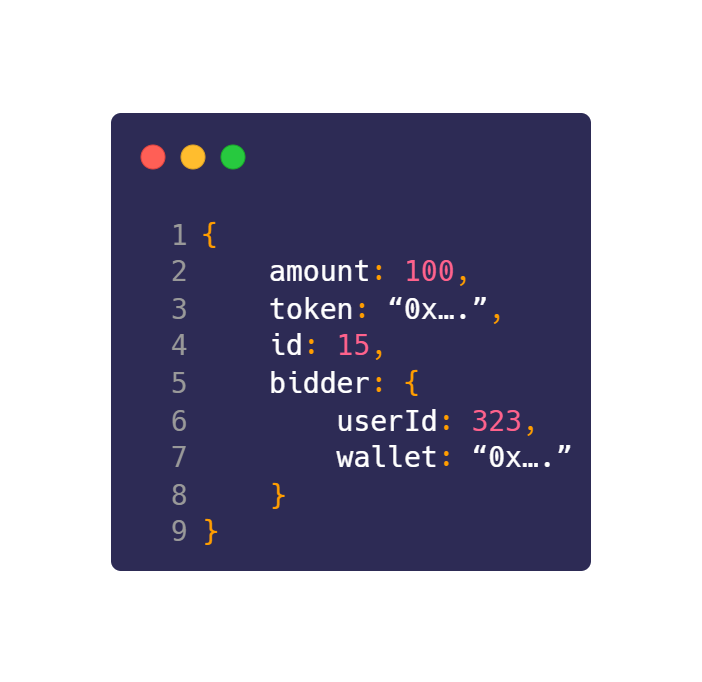


- From this JSON structure, derive two data structures: Bid and Identity.
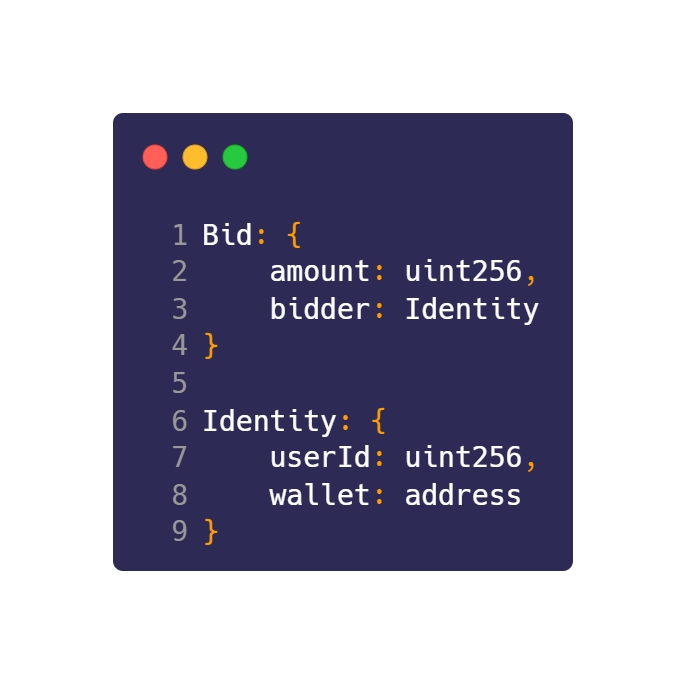


- These data structures will be used in your Solidity code, so ensure they align with the EIP-712 standard data types.
Step 2: Build Your Domain Separator
- The domain separator is a crucial part of EIP-712 as it prevents signatures from one dApp from working in another. It is constructed based on the following fields:
– ‘name’: The name of your dApp or protocol, e.g., “Dapp for crypto.”
– ‘version’: The version of your dApp or platform.
– ‘chainId’: The EIP-155 chain id, ensuring signatures are valid only on the correct network (e.g., “1” for the Ethereum mainnet).
– ‘verifyingContract’: The Ethereum address of the contract that will verify the signature.
– ‘salt’: A unique 32-byte value hardcoded into both the contract and the dApp.
- Here’s an example of a domain separator:
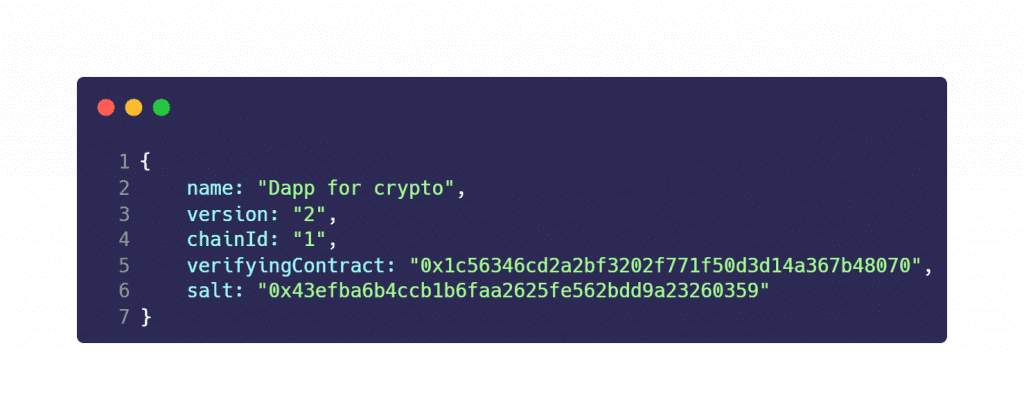


- Developers must ensure that the ‘chainId’ corresponds to the network you are deploying on.
Step 3: Create a Signing Code for Your dApp
- Define your data types in JavaScript for use in your dApp. This includes domain, bid, and identity.



- Define your domain separator and message data based on the previous steps.
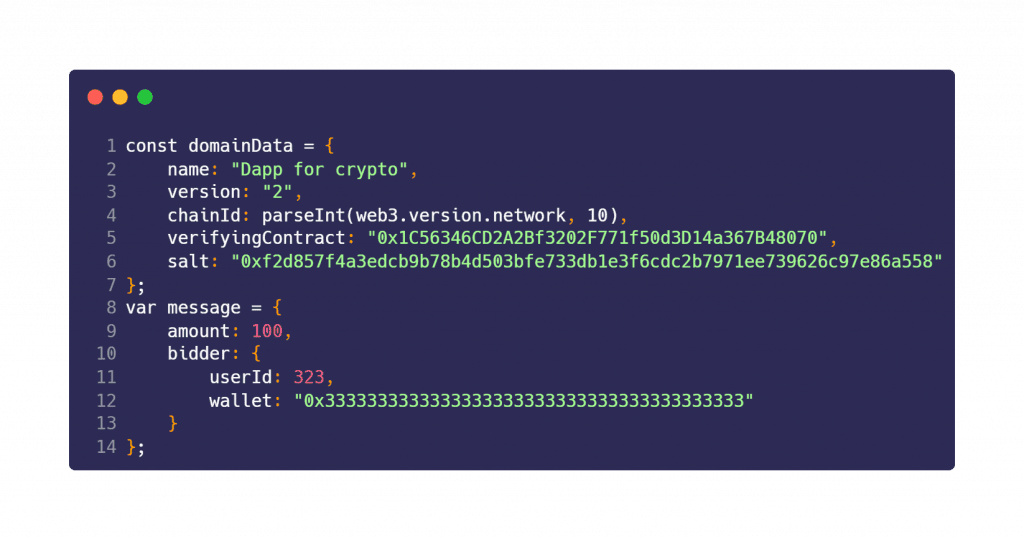


- Create a `data` variable that combines all the information into a JSON structure that conforms to the EIP-712 standard.
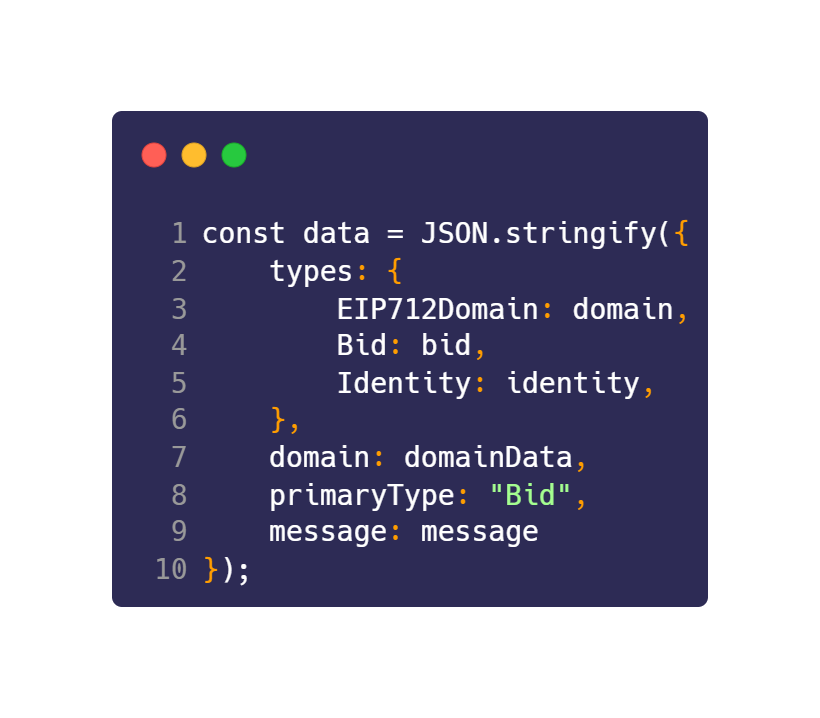


- Use the ‘eth_signTypedData_v3’ function to sign the data with MetaMask or another compatible wallet.
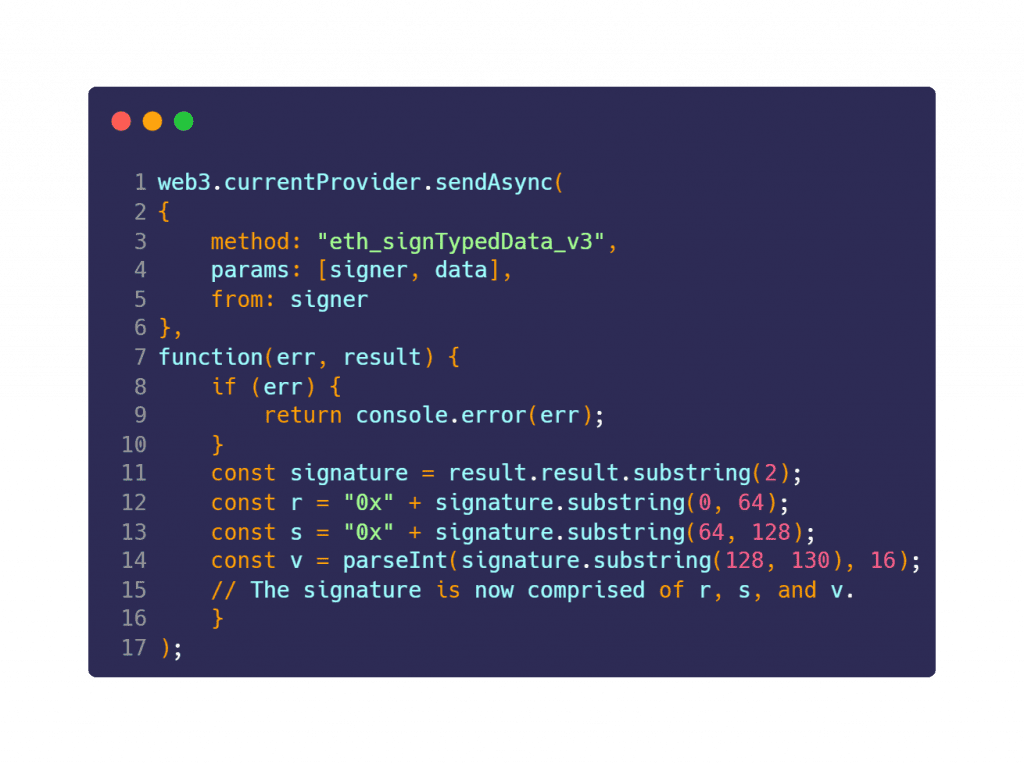


Step 4: Writing Authentication Code for the Verifying Contract
- In your Solidity contract, declare the data types (Identity and Bid) to match the data structures used in your JavaScript code.
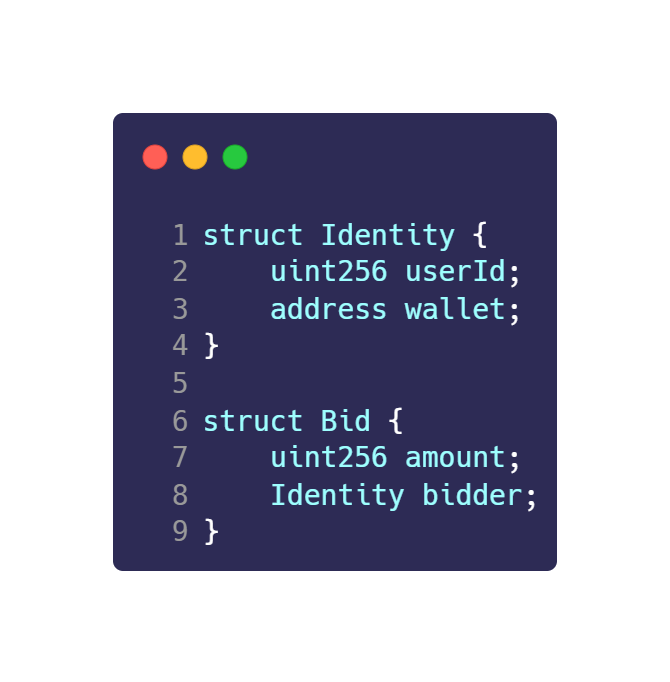


- Define the type hashes for each data structure.



- Construct the domain separator type hash based on the domain separator you created earlier.
- Write hash functions for each data type (e.g., `hashIdentity` and `hashBid`) to format and hash the data for verification.
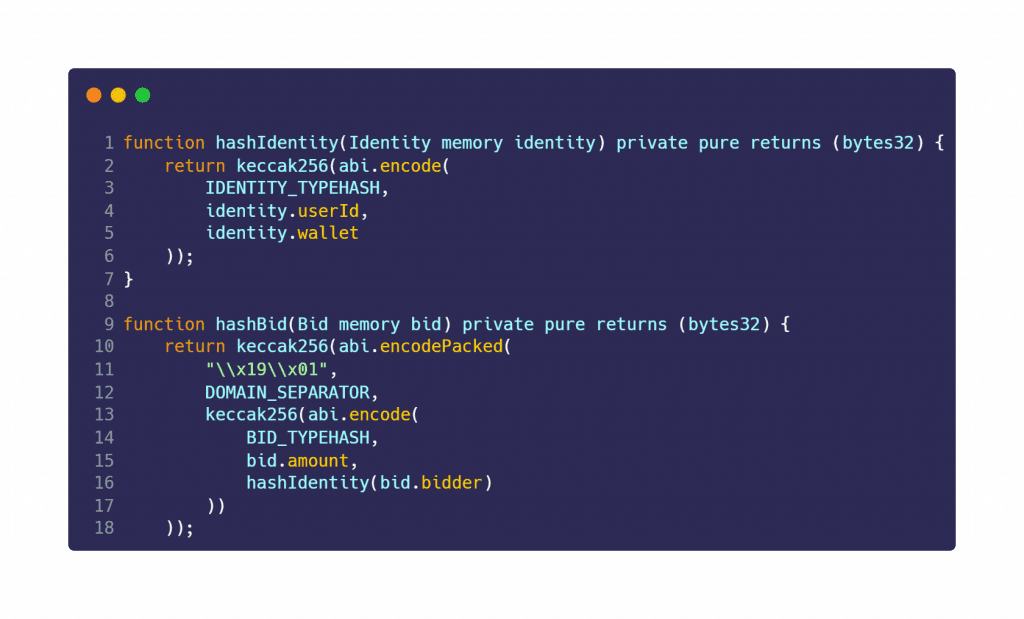


- Finally, create a `verify` function that uses the `ecrecover` function to verify the signature by comparing it to the signer’s address.



Advantages of EIP-712: Boosting User and Developer Experience
1. Clarity and User-Friendly Interaction
EIP-712 enhances the user experience by presenting data in a clear, human-readable format. This transparency empowers users to fully comprehend the content they are signing, reducing the likelihood of accidental transactions or approvals due to confusion.
2. Fortified Security
The structured signing process implemented by EIP-712 ensures that users have a complete understanding that acts as a robust defense against malicious actors attempting to deceive users into signing harmful or unauthorized data.
3. Mitigated Signature Replay Threats
EIP-712 incorporates a domain separator, assigning a unique identifier to data signed for each application. This feature significantly diminishes the risk of signature replay attacks across various applications, enhancing overall security.
4. Streamlined Development
EIP-712 introduces a standardized approach for signing and verifying typed data. This standardization simplifies the development process for creators, enabling them to build secure and user-friendly applications that seamlessly interact with the Ethereum blockchain.
Final Notes
EIP-712 standardizes data signing and verification, streamlining dApp development for a more secure and user-friendly Ethereum blockchain. Thereby, this offers substantial advantages to both users and developers in the Ethereum ecosystem.






















